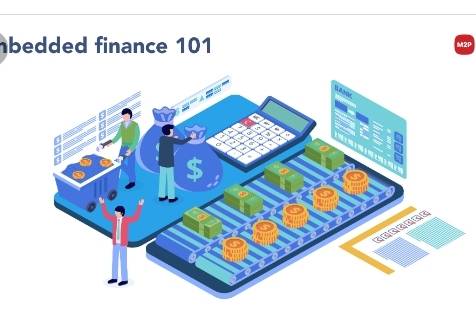Embedded finance integrates financial platforms, apps, or enterprises with financial services or products. This idea enables businesses to provide financial services to their clients without requiring them to go to a different financial institution.
Banks, credit unions, and other specialized financial organizations have always offered financial services. However due to the development of digital technology and APIs (Application Programming Interfaces), companies from a wide range of sectors can now directly include financial services in their offerings.
Examples of embedded finance include:
Peer-to-Peer Payments: Within the same messaging or social networking app, users can send money to friends and family.
Digital wallets: To enable in-app payments, retail and food delivery apps contain digital wallets.
Personal Finance Tools: Non-financial apps incorporate money management tools for their users, such as budgeting, saving, and investment functions.
What Are The Types Of Embedded Finance?
Payment Services: In order to allow users to conduct transactions inside the application, payment processing capabilities must be integrated into non-financial platforms. Peer-to-peer payments, in-app purchases, and mobile wallets are a few examples.
Buy Now, Pay Later (BNPL): Customers can split payments into installments when making purchases using BNPL services, which are generally used in retail and e-commerce applications.
Lending and Credit: Embedded lending services are provided by some platforms, enabling customers to obtain loans, credit lines, or financing choices right from the application.
Insurance Services: Businesses might provide insurance protection suited to particular goods or services, including trip insurance, device protection plans, or rental insurance.
Embedded Banking Services: This refers to collaborating with banks or neo-banks to provide banking services, including checking accounts, debit cards, and other financial goods, inside the non-financial platform.
How Does Embedded Finance Work?
The goal is to seamlessly integrate financial capabilities into current ecosystems to give users a more convenient and all-encompassing experience. Here's how embedded finance works:
1) Partnerships and APIs: Financial institutions (banks, fintech startups) partner with non-financial enterprises (such as e-commerce platforms, ride-hailing applications, or healthcare providers) to enable embedded finance. Application Programming Interfaces (APIs) are frequently used to facilitate these collaborations.
2) API Integration: APIs are collections of protocols and technologies that enable data sharing and communication between various software programs. APIs allow non-financial platforms to easily access and make use of financial services in the context of embedded finance.
3) Seamless User Experience: After being integrated via APIs, financial products and services are fully integrated into the non-financial platform's user experience. A seamless and practical user experience is achieved since users can use these services without leaving the program they are now using.
4) Financial Data and Analysis: Embedded finance enables companies to compile extensive data on customer financial preferences and behavior. To provide individualized financial advice and enhance services, this data can be analyzed.
5) Risk Management and Compliance: Financial institutions incorporated into non-financial platforms are required to make sure that the necessary risk management and compliance protocols are in place. This entails confirming user identities, avoiding fraud, and abiding by pertinent laws.
6) Financial Inclusion: By giving those who might not have typical bank accounts or have restricted access to financial institutions access to financial services, embedded finance can support financial inclusion.
7) New Revenue Streams: This integration can generate new income streams for companies that provide embedded financing through fees, commissions, or interest on financial products.
8) Security and Privacy: In embedded finance, protecting the security and privacy of users' financial information is crucial. To protect user data, stringent encryption, authentication, and data protection methods must be used.
In the end, embedded finance benefits both financial institutions and non-financial companies. Financial organizations can access new consumer categories and distribution methods, while non-financial enterprises can broaden their service offerings and boost customer engagement.
Embedded finance is predicted to significantly alter the financial landscape as technology and regulation both advance.
Why Embedded Finance Is Important?
Numerous advantages of embedded finance can completely alter how financial services are provided to both consumers and enterprises. Embedded finance offers a number of significant benefits, including:
Seamless user experience: Embedded finance removes the need for users to visit different applications or websites by integrating financial services directly into already-existing platforms, goods, or services. The user experience is smoother and more practical as a result of this seamless connection.
Increased accessibility: More people, especially those without conventional bank accounts, may readily access and use financial goods thanks to the integration of financial services into commonplace platforms and applications. By doing this, you can reach marginalized groups and promote financial inclusion.
Enhanced customer engagement and retention: Businesses can provide their clients with more value by integrating financial services into an already established ecosystem.
Streamlined operations and cost reduction: Businesses can save operational expenses, simplify processes, and require less additional infrastructure by integrating banking services. For startups and small businesses wishing to increase their service offerings without incurring considerable overhead, this might be especially helpful.
Data-driven insights: Businesses can collect more thorough data about consumer behavior and preferences with embedded finance. To better understand consumer behavior, provide more individualized services, and make wise business decisions, this data can be analyzed.
Faster and more secure transactions: Modern payment systems and technologies, like mobile wallets, blockchain, and digital currencies, are frequently used in embedded finance. By enabling quicker and more secure transactions, these technologies can lower the risk of fraud and increase overall payment efficiency.
New revenue streams and business opportunities: Businesses can take advantage of cross-selling opportunities and unlock new revenue streams by integrating financial services.
Overall, embedded finance has the power to change the financial landscape by improving the usability, efficiency, and accessibility of financial services for both enterprises and consumers.


